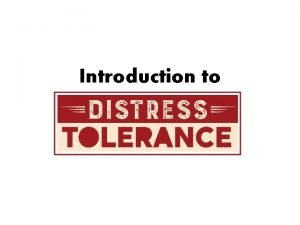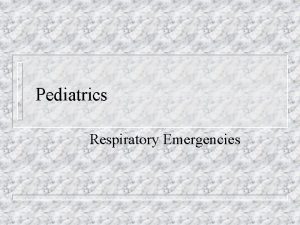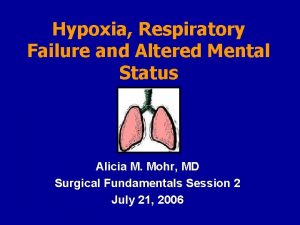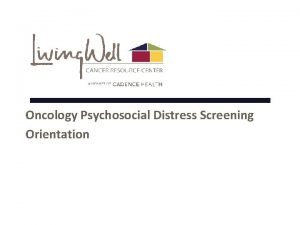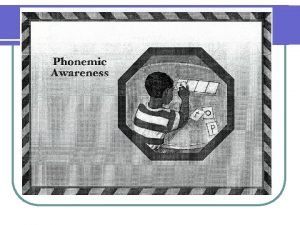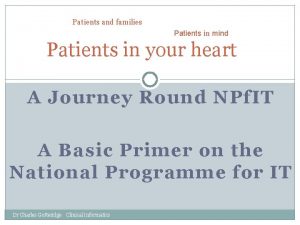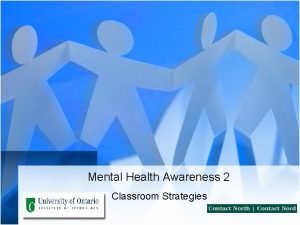Supporting patients in mental distress awareness and good




































- Slides: 36

Supporting patients in mental distress – awareness and good practice a PLT programme for: Practice Nurses and HCA’s 4 March 2014 Delivered by: Aly Anderson

Objectives As a result of this session, you will: • Understand what is meant by the term ‘mental health’ • Be able to recognise symptoms of mental health problems (specifically in relation to depression, anxiety disorders and psychosis). • Be able to respond appropriately to someone in mental distress • Have a basic understanding of how to assess the risk of suicide • Understand the importance of looking after your own mental wellbeing.

What is mental health? Work in pairs: Come up with a definition and/or list of words that you think of when you think of the term ‘mental health’.

What is mental health? “Mental health influences how we think and feel about ourselves and others and how we interpret events. It affects our capacity to learn, to communicate and to form, sustain and end relationships. It also influences our ability to cope with change, transition and life events: having a baby, moving house, experiencing bereavement. ” (Mental Health Improvement ‘concepts and definitions’, Friedli, L. 2004) Everyone has mental health

World Health Organisation definition: • A positive sense of well being • A belief in one’s own worth and the dignity and worth of others • The ability to deal with the inner world of thinking, feeling, managing life and taking risks • The ability to initiate and sustain mutually satisfying personal relationship • The ability of the mind to recover from shock and trauma

What is a mental health problem? • A mental health problem is a disturbance in the way in which a person thinks, feels and behaves. • Mental ill-health can happen to anyone – and it’s on a continuum • Most of us go through periods where we feel ‘down’ and/or anxious • A diagnosable mental health problem is where symptoms tend to be more severe, are longer lasting and affect our ability to function • Wide range of diagnosable conditions

Some mental health conditions • Depression • Anxiety – including OCD, phobias, PTSD and Panic disorder • Psychotic disorders – bipolar disorder, schizophrenia

The Mental Health Continuum Optimal Mental wellbeing Optimal mental wellbeing with diagnosable mental health issue Optimal mental wellbeing without mental health issue Serious diagnosable mental health Issue No symptoms of mental heath issue Poor mental wellbeing with diagnosable mental health issue Poor mental wellbeing without a diagnosable mental health issue Poor Mental wellbeing

Mental Health Facts • 1 person in 4 experiences some form of mental health issue every year and, right now, 1 in 6 workers is dealing with a mental health related problem such as anxiety, depression or unmanageable stress Source: ONS (2009) • This week, in England, approximately 80 people will take their own lives. Three quarters of them are likely to be men (based on ONS figures 2009) • £ 30. 3 billion is the estimated annual loss of output within workplaces (England) due to mental ill-health Source: Centre for Mental Health (2009)

Risk factors for mental health issues • • Prolonged exposure to stress Traumatic life events Physical health problems Isolation Genetic predisposition Lack of support Bereavement Drug/alcohol misuse. . .

Risk factors for mental health issues • • • Disability Poor housing/homelessness Abuse Unemployment Homelessness Discrimination

Protective Factors • • Supportive social networks Physical exercise Positive coping strategies Communication skills Emotional literacy Problem solving abilities Arts and culture Confidence/self-belief. . .

Protective Factors • • • Balanced diet Respectful relations Values and beliefs Tolerant, supportive community Rest and reflection

Mental health myths True or False?

Signs and symptoms of anxiety and depression Group Exercise - identifying symptoms: - Physical - Behavioural - Psychological (thoughts and feelings)

Depression • • Persistent sadness, Loss of interest, difficulty concentrating Irritability, negativity Mood swings Loss of confidence/self esteem Undue feelings of guilt, hopelessness/worthlessness Thoughts of suicide and/or self harm

Depression cont’d. . . • • • Persistent tiredness Unexplained aches and pains Gaining/losing weight. Sleeping too much, too little Loss of libido Avoiding others Stopping enjoyable interests/hobbies Eating too much/too little Self harm. . .

Anxiety • • • Palpitations Chest pain Stomach problems, nausea muscle aches Headaches, dizziness Feeling ‘on edge’ Panic attacks Anger, confusion Excessive fear & worry Unwanted repetitive thoughts

Anxiety cont’d. . . • • Mind racing Irritability Sleep difficulties Difficulties with decision-making Avoidance Repetitive behaviours Phobic behaviours (discomfort &urge to escape)

Panic attack symptoms Symptoms may include: • Chest pain/discomfort • Nausea • Fear of dying • Numbness/pins & needles • Sweating • Feelings of detachment • Increased awareness of heart beat • Trembling/shaking

Psychosis is an umbrella term used to describe conditions which affect the mind, where there has been a distortion of reality involving: - Hallucinations (false perceptions) such as hearing voices or seeing people who aren’t there - Delusions – false beliefs, possibly including paranoid thoughts. - Disordered thinking Violence is not a symptom of psychosis Psychosis is a significant risk factor for suicide

Schizophrenia • Not ‘split personality’ • A psychotic illness in which the changes in behaviour or symptoms have been present for at least 6 months • Many people with schizophrenia lead full and happy lives • Many people with schizophrenia make a full and sustained recovery

Bipolar Disorder • Extreme highs (mania) alternate with lows (depression). • Bipolar disorder may be psychotic or non-psychotic • When psychosis occurs it is in context of general mood disturbance. • Symptoms of mania include: lack of inhibitions, grandiose delusions, elated mood, needing less sleep that usual.

Supporting someone in distress Group activity – case study

Suicide warning signs • • Expressions of hopelessness or helplessness Feeling trapped – like there is no way out of a situation Overwhelming sense of shame or guilt A lack of interest in the future Written or spoken notice of intention to end own life Withdrawing from family/friends Giving away possessions, putting affairs in order • Sudden unexplained ‘recovery’

Suicidal thoughts • Suicidal behaviour is on a continuum • It is a myth that if someone talks about suicide they are less likely to complete suicide • Don’t be afraid to ask about suicide – it’s good practice and you won’t do any harm by asking/listening • Confidentiality never applies to suicide

Being supportive • • • Encourage the person to talk – and listen to them Silence – can be very supportive Ask what you can do to help Be encouraging, hopeful and reassuring Offer support rather than solutions Refer to other professionals as appropriate

Non-judgemental listening is about: • Accepting people exactly as they are • Genuinely making no moral judgement about their situation • Empathically trying to get on their wavelength

Empathy Putting oneself in the other person’s shoes and seeing what the world looks like and feels like; conveying this understanding to the other person.

How would you feel if. . . • You were really upset about something but people kept telling you to stop worrying about it? • You were in unbearable pain and nobody wanted to help you. • You went somewhere the people around you kept talking about you behind your back and writing things down about you. • People kept telling you, over and over again, that you were bad, ugly and a waste of space.

Empathy While you may not always understand what is going on for an individual, you can demonstrate empathy by reflecting back the feelings that the individual is expressing.

Next steps for patients in distress • If you believe that a patient is suicidal, refer them to a doctor as soon as possible. Ensure that someone stays with them until that appointment. • If you think someone is having a panic attack, treat as an emergency and call doctor. • If patient is showing signs of psychosis, call doctor for immediate assessment.

Recovery from mental health problems • With the right support, most people recover from mental health problems. • For some, recovery may not about a total absence of symptoms but is more about the individual building a personally meaningful and satisfying life. • Individuals manage their symptoms in a variety of different ways. There is no ‘one size fits all’. • Hope is crucial to recovery.

Looking after yourself • Supporting someone in distress can impact on your own wellbeing • Prolonged, unsupported workplace stress is a risk factor for mental ill-health • Be sure to look after your own mental health. . .

Looking after yourself Five Ways to wellbeing. . . 1. Connect 2. Be active 3. Take notice 4. Keep learning 5. Give

Evaluation We are always keen to hear how our training can be improved, so please complete the evaluation sheet. Copies of today’s powerpoint slides will be sent to you by Sheona Dalton- Workforce development. Thank you!
 Psychology, mental health and distress
Psychology, mental health and distress Privacy awareness and hipaa privacy training cvs
Privacy awareness and hipaa privacy training cvs Objective for mental health awareness
Objective for mental health awareness Poem on mental health awareness day
Poem on mental health awareness day Titles for mental health presentations
Titles for mental health presentations Zoroastrian good thoughts
Zoroastrian good thoughts Good morning good afternoon good evening
Good morning good afternoon good evening Good evening good morning good afternoon
Good evening good morning good afternoon Nothing compares to your embrace
Nothing compares to your embrace Hello good afternoon teacher
Hello good afternoon teacher Mental health and mental illness chapter 20
Mental health and mental illness chapter 20 Eutress
Eutress Eustress meaning
Eustress meaning Moral distress and burnout
Moral distress and burnout Mental health jeopardy questions and answers
Mental health jeopardy questions and answers Write a short note on stress management
Write a short note on stress management Leonard pearlin's theory of psychological distress
Leonard pearlin's theory of psychological distress Leonard pearlin's theory of psychological distress
Leonard pearlin's theory of psychological distress Nst vs ctg
Nst vs ctg Damsel in distress archetype example
Damsel in distress archetype example What is an archatype
What is an archatype Nursing management of fetal distress
Nursing management of fetal distress Distress traffic
Distress traffic Distress signal x1
Distress signal x1 Fetal distress definition
Fetal distress definition Verbalisasi distress adalah
Verbalisasi distress adalah Suds thermometer
Suds thermometer Respiratory distress
Respiratory distress Manashakti
Manashakti Materi psikologi klinis
Materi psikologi klinis Direct costs of financial distress
Direct costs of financial distress Emotional thermometer
Emotional thermometer Tip dbt
Tip dbt Contoh distress
Contoh distress Respiratory distress
Respiratory distress Occuring after death
Occuring after death Respiratory distress nasal flaring
Respiratory distress nasal flaring


























